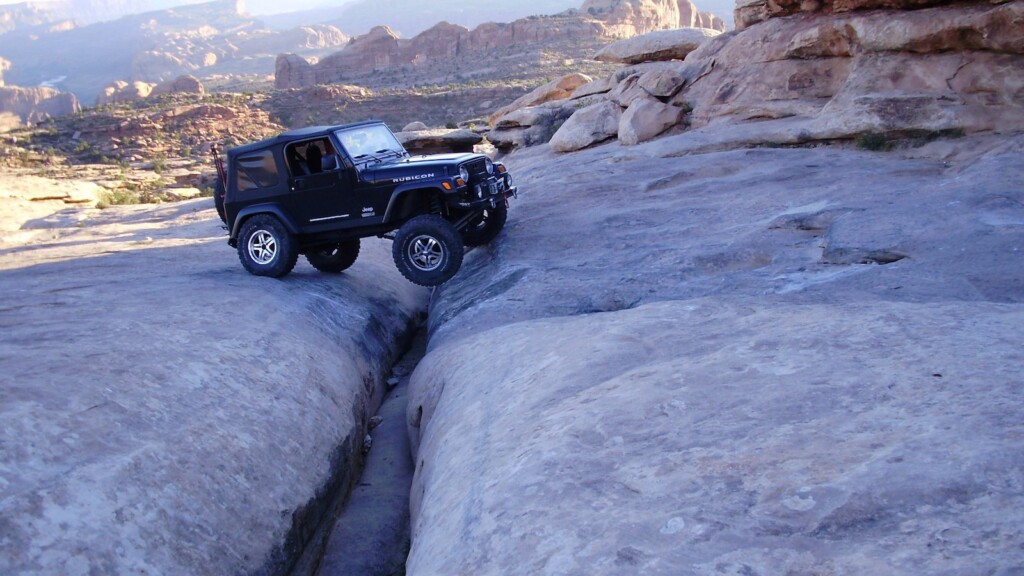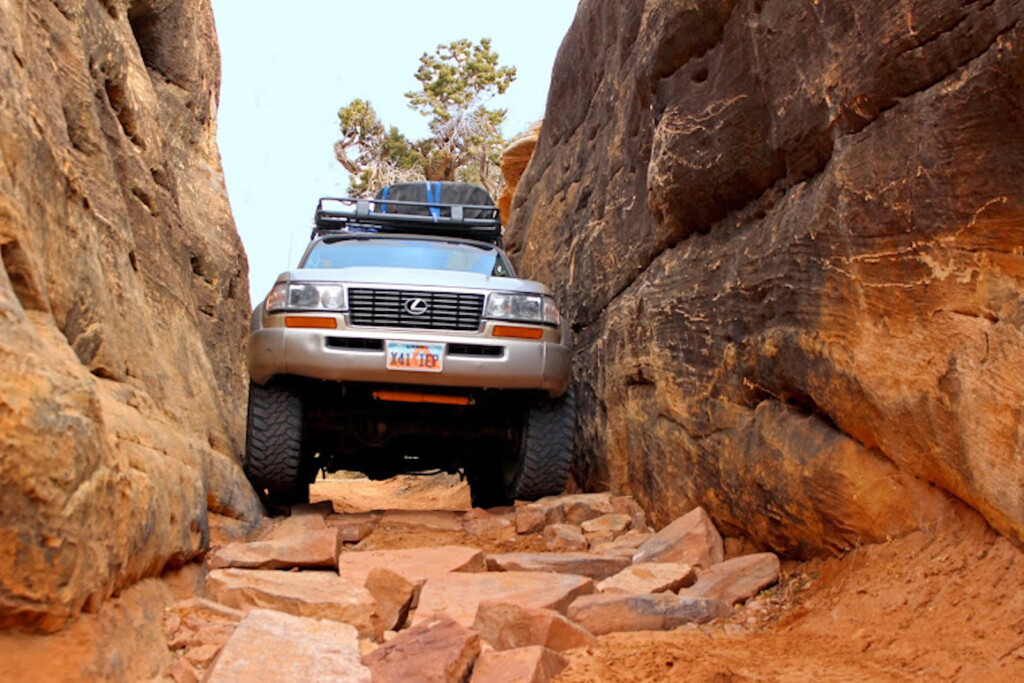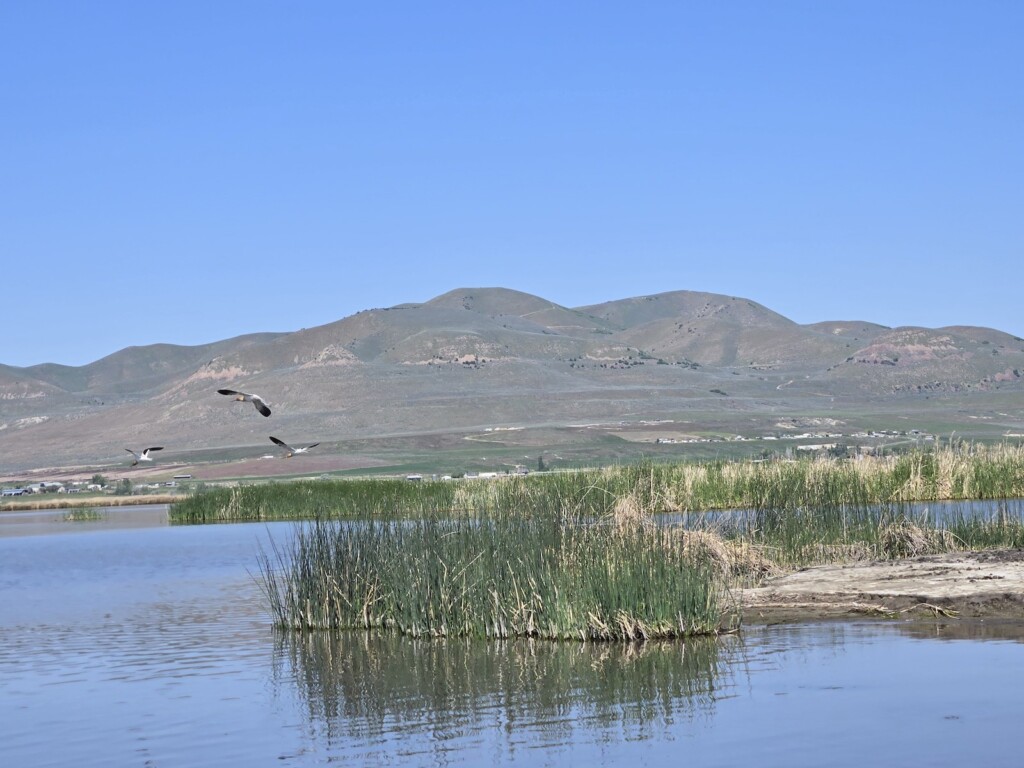Easter weekend is one of the largest gatherings of Jeep and off-road enthusiasts in the world. Moab, Utah has gained a reputation for being one of the best places to off-road for a number of reasons. But as I’ve been told, the main reason is that the uranium mining boom in the 1940s and 1950s in Moab led to the building of some of the most interesting roads and trails through some of the hardest rock found anywhere.
It was thanks to “greedy miners” seeking yellow cake uranium that the trails were carved out and formerly inaccessible canyons and spectacular scenery were made accessible. This led to the creation of the Shafer Trail and White Rim Trails, which are arguably some of the best off-road vehicle trails in the world. And while neither of those trails were included in the BLM closures, there are other trails designated under “protected status” that are now closed to vehicle travel. Now, Moab’s off-road community is quietly voicing their opinions on these closures.

In 2023, the Bureau of Land Management closed 317 miles of OHV trails west of Moab. The trails closed were in the Labyrinth Rims/Gemini Bridges Special Recreation Management Area, and 300,000 acres in Grand Canyon that abuts a 40-mile stretch of the Green River.
Trails closed included Day Canyon Point, Deadman Point Overlooks, Hell Roaring Canyon, Hey Joe Canyon, Mashed Potatoes, and Ten-Mile Canyon.
The closures were made for preservation purposes. The BLM claimed that road closures were necessary to protect riparian habitats, preserve cultural resources and minimize damage to watersheds and vegetation. They also said conflicts between motorized and non-motorized users were used as a justification for some road closures.
Environmentalists were happy with the closures while motorists felt unheard. State leaders also called the road closures an example of federal overreach.

Both the State of Utah and motorized recreation groups have appealed the BLM decision, and a decision from the Interior Board of Land Appeals will be made in October, 2024. The roads remain closed pending the appeal. The off-roading groups also appealed to federal court to keep the roads open until a final decision could be reached. U.S. District Judge Dale Kimball denied the preliminary injunction.
The Salt Lake Tribune reported, “On the last day of the 2024 session, the Utah Legislature passed HB471: Public Lands Possession Amendments, sponsored by Rep. Phil Lyman, R-Blanding, who is running for governor this year. The legislation says that Utah and its counties can “disregard any attempted closure of a road without due process.”
The Bill passed and goes into effect May 1, 2024.
Many popular trails were not included in the closures, including Hells Revenge, Poison Spider Mesa, Top of the World, and more, but people can still come from all over the world to ride Moab’s trails.
One of the key factors for justifying the closures is that some motorized off-roaders were not staying on the trails. The problem is that if even just a few motorists don’t remain on the trails, it spoils it for everyone because the ecosystems are easily damaged.
Utah Stories reached out to two Moab area locals who both operate off-road touring companies for their opinions on the closures.
Jason Taylor is the owner of Canyonland Jeep Rentals. He says that his business has experienced little to no impact so far because “Most of the people who rent jeeps from us don’t generally go to the areas that were closed. Those areas are harder to get to and people who rent from us usually want a mellow, scenic trip closer to town. Some of the trails that were closed, like Mashed Potatoes and Hey Joe Canyon, are usually frequented by people who have their own vehicles. Not a whole lot of people went there.”
Taylor added that the greater problem is the public’s perception.
“Where it has hurt us is the media perception of Moab being shut down or closed. It is coming across in the media and through certain groups that all of Moab is closed, that they’ve closed down everything. It’s not true. There are still a lot of trails open where our clientele would generally go. That being said, I hate to see the trails that were closed shut down. They provide recreation for certain.”
Taylor continues: “People who heard about closures come in and want to rent Jeeps, but they’ve heard everything is closed. We are able to show them areas that are open. Not everyone who comes in has heard about the closures. It is probably about 50/50. People from out of state have mostly not heard about it.”
Furthermore, Taylor says, “We are not involved in the lawsuits although we support keeping the trails open. It is all about conservation and people staying on the trails. We do a good job of educating people to correct trail behavior. It is hard to judge at this point if business and tourism will drop in Moab due to the trail closures. The season just started and we won’t be able to see the consequences and repercussions until the end of the season. We would also need to take into account what happens with other rental places in town. Our company does not provide tours like some of the other places; we strictly do rentals. I think the tour companies will see a bigger impact.”

Brian Martinez is one of the owners and operators of Navtec. Navtec, unlike Canyonland Jeep Rentals, does offer fully-guided tours from a big lineup of Land Cruisers. Martinez says that the closures have indirectly impacted his business.
“Our 4×4 tours are mainly in the National Parks backcountry, but we get a lot of calls asking if Moab is closed. I also field questions from raft rentals on Labyrinth concerned that Mineral or the road to Ruby Ranch was part of the closures.”
Martinez says he did see fewer visitors last year than in the previous few years, but there were other contributing factors for the decline. Covid was a massive boon for Moab touring companies because outdoor activities saw an increase in that period. But Martinez says the closures have negatively impacted Moab’s image.
“The public in general is very confused about what is closed. Do a Google search and you get articles describing the controversy but no specifics,” he said.
Martinez added that he recently spoke to some German tourists visiting Moab and all that they knew was that, “It closed its trails.” Martinez added that it would be nice to have an authority list the closed trails from the final decision,” but he added, “Good luck deciphering the maps.”
Utah Stories asked: Do you have an official position on the closures?
“I don’t think they took a balanced approach. I spend a lot of time recreating in that area and I have not seen the level of conflicts that would warrant closures. I camp, hike, mtb, shoot, dirt bike, and boat all over that country. I also operate commercial labyrinth canyon river trips, rent boats and run shuttles for private river runners. Overall, the previous multi-use management of the area appeared to be well balanced. The mining history and roads associated are part of the significant statement of Canyonlands National Park. While these closures are outside and not protected by the park, their significance is no less. The roads that were closed have generational ties to families and the land.”
US: Would you like to see the decision reversed, or not?
“Yes, I would like to see a common sense approach to this and all six of the management plans open in this area. I’m tired of the winner’s and loser’s game. Let me tell you, special interest groups are not looking out for you.”
US: Do you think trail etiquette and education would be as effective as closing trails?
“These closures are due to lawsuits from wilderness groups. Trail etiquette and education have been going on for a long time and have been shown to be very effective. I see more friendly encounters on the trail than disrespect, but there is a need for more education and enforcement in all of the backcountry. Closures are the lack of management as access is denied to all but a very few. This is nothing more than a spoiled brat throwing a tantrum because he can’t have the sandbox to himself.”
US: Do you have a favorite trail that is now no longer accessible to you?
“My two boys grew up dirt biking in Ten-Mile Wash. I don’t have that privilege anymore.”
Feature Image of Moab by Richard Markosian.






